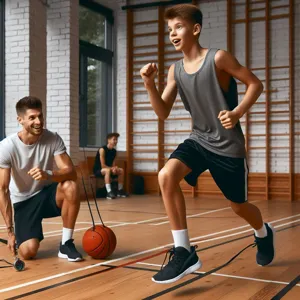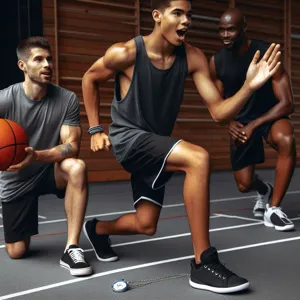Whether you’re a seasoned player looking to refine your skills or a newcomer eager to make your mark on the court, conditioning is the cornerstone of a successful basketball game.
The thrill of driving to the hoop, making that perfect three-pointer, or executing a flawless play can only be fully realized when your body is primed for peak performance. In our upcoming blog post, “Elevate Your Game: Proven strategies to Boost Basketball Conditioning,” we’ll explore an array of effective training techniques and tips tailored to enhance your endurance, agility, and strength. From high-intensity interval training to sport-specific drills, we’ll delve into the methodologies that elite athletes swear by. Prepare to transform your game, unlock your potential, and dominate the court like never before! Whether you’re aiming to outrun your opponents or outlast them, this guide is your playbook for success.
1. Understanding the Importance of Basketball Conditioning

Basketball conditioning is the backbone of any successful player’s performance on the court. It encompasses much more than just running drills or hitting the gym; it’s about developing the specific physical attributes that enhance your game. When you think about the fast-paced nature of basketball, with its explosive sprints, sudden stops, and high-intensity plays, it becomes clear that conditioning is not just beneficial—it’s essential.
In a typical game, players engage in short bursts of high-intensity activity, which demand not only speed and strength but also endurance and agility. These elements allow players to maintain peak performance in the fourth quarter, when fatigue can become a deciding factor in the game. Conditioning helps build the stamina necessary to outlast opponents, ensuring that you can keep pushing your limits even when others are wearing down.
Moreover, basketball conditioning is crucial for injury prevention. A well-conditioned athlete is more resilient to the physical toll of the sport, as strong muscles and joints are better equipped to handle the demands of quick lateral movements and jumps. By investing time in specific training routines that enhance your overall fitness, you reduce the risk of common injuries, such as ankle sprains or knee issues, allowing you to play longer and at your fullest potential.
Understanding the importance of conditioning also extends to mental preparedness. A player who is in top physical shape not only feels more confident but also possesses the mental fortitude to push through challenging moments in a game. The connection between physical fitness and mental clarity cannot be overstated; as your body adapts to the rigors of conditioning, your mind becomes sharper, enabling better decision-making under pressure.
In summary, basketball conditioning is a multifaceted approach that elevates not only your physical capabilities but also your mental game. By recognizing its critical role, you’re setting the foundation for a successful basketball journey—one where you can outlast, outperform, and outsmart your competition.
2. Key Components of Basketball Fitness
To truly elevate your game on the court, understanding the key components of basketball fitness is essential. Basketball is a dynamic sport that requires a unique blend of physical attributes to perform at peak levels. Here are the primary components to focus on:
**1. Cardiovascular Endurance:** Basketball is a fast-paced game that demands high levels of stamina. Players are constantly running, jumping, and changing direction, making cardiovascular endurance critical. Incorporating activities such as interval training, long-distance running, and cycling into your routine will help improve your heart and lung capacity, enabling you to maintain high energy levels throughout the game.
**2. Speed and Agility:** Quickness is vital in basketball, whether you’re sprinting down the court on a fast break or making sharp cuts to evade defenders. Agility drills, such as shuttle runs and ladder exercises, can enhance your footwork and reaction time, allowing you to outmaneuver your opponents. Furthermore, practicing explosive movements, like box jumps and plyometrics, can increase your overall speed.
**3. Strength Training:** A strong physique not only helps you withstand physical challenges on the court but also enhances your performance. Focus on building strength in your legs, core, and upper body through weight training exercises like squats, deadlifts, and bench presses. Additionally, incorporating bodyweight exercises such as push-ups, pull-ups, and lunges can improve your functional strength, which is essential for rebounding and finishing at the rim.
**4. Flexibility and Mobility:** To prevent injuries and improve your overall performance, maintaining flexibility and mobility is crucial. Regularly incorporating stretching routines, yoga, or dynamic warm-ups can enhance your range of motion, allowing for smoother movements during play. This is especially important for executing quick pivots and explosive jumps, which are fundamental in basketball.
**5. Basketball-Specific skills:** Beyond general fitness, honing your basketball-specific skills is vital. Dribbling drills, shooting practices, and defensive footwork exercises are essential components that should be integrated into your conditioning program. These drills not only build skill but also improve your fitness levels by incorporating game-like movements that stress your body in similar ways to an actual game scenario.
By focusing on these key components, you’ll create a comprehensive conditioning plan that prepares you not just to play but to excel in basketball. Remember, a well-rounded approach to fitness will elevate your game, allowing you to perform at your best when it matters most.
3. Assessing Your Current Conditioning Level

Before embarking on any journey to elevate your basketball conditioning, it’s crucial to take a step back and assess where you currently stand. Understanding your fitness baseline not only provides a starting point for your training but also allows you to track your progress as you advance.
Begin by evaluating your cardiovascular endurance, strength, and agility—three key components that play a pivotal role in your performance on the court. One effective method is to perform a series of fitness tests. For cardiovascular endurance, consider a 12-minute run or a beep test to gauge how well you can sustain effort over time. For strength, simple exercises like push-ups, squats, and bench presses can help you determine your current capabilities in relation to your body weight and overall strength.
Next, focus on your agility with drills such as the shuttle run or the T-drill, which mimic the quick lateral movements required during a game. Record your times and repetitions meticulously; this data serves as a benchmark against which you can measure your improvement as you progress through your conditioning regimen.
Additionally, don’t overlook the importance of self-assessment in terms of your mental conditioning. Mental fortitude plays a significant role in basketball performance, and reflecting on your psychological readiness can be just as telling as physical tests. Consider journaling about your motivation levels, confidence in your skills, and ability to handle stress during games.
Once you have a clear picture of your current conditioning level, you can set realistic, measurable goals tailored to your specific needs. Whether you’re aiming to improve your endurance for those demanding fourth-quarter sprints or build explosive power for dominating the paint, understanding where you’re starting from is essential. With this knowledge, you can craft a targeted training plan that will keep you focused and motivated on your path to becoming a better basketball player.
4. Developing a Personalized Conditioning Plan
Creating a personalized conditioning plan is essential for any basketball player looking to elevate their performance on the court. Unlike generic workout routines that often overlook individual strengths and weaknesses, a tailored plan takes into consideration your unique physical capabilities, playing style, and specific goals.
Start by assessing your current fitness level. This involves understanding your endurance, speed, strength, and agility. Consider working with a coach or trainer to conduct baseline tests that measure your vertical jump, sprint times, and overall stamina. These metrics will serve as your starting point and help you identify areas that need improvement.
Next, set clear, achievable goals. Whether you’re aiming to increase your vertical leap to enhance your dunking ability, improve your lateral quickness for better defensive maneuvers, or boost your endurance for those grueling fourth quarters, having defined objectives will keep you focused and motivated.
Incorporate a variety of training elements into your plan. Skill-specific drills, interval sprints, strength training, and flexibility exercises should all find a place in your routine. For example, plyometric exercises can significantly enhance your explosive power, while agility drills help you navigate the court with finesse. Additionally, don’t underestimate the importance of recovery; schedule rest days and incorporate active recovery techniques like yoga or light swimming to prevent burnout and injury.
Lastly, always be willing to adapt your plan as you progress. Regularly revisit your goals and performance metrics to ensure that your conditioning program is leading you closer to your aspirations. By committing to a personalized conditioning plan, you not only enhance your physical capabilities but also build a strong mental game, positioning yourself for success on the hardwood.
5. High-Intensity Interval Training (HIIT) for Basketball

High-Intensity Interval Training (HIIT) has emerged as a game-changer for athletes seeking to elevate their basketball conditioning. This training method, characterized by alternating bursts of intense exercise followed by short recovery periods, mirrors the dynamic nature of a basketball game, where players sprint, jump, and shift directions in quick succession.
Incorporating HIIT into your training regimen not only enhances cardiovascular endurance but also improves agility, speed, and overall performance on the court. A typical HIIT session might involve exercises like sprinting for 30 seconds, followed by a 15-second rest, then switching to basketball-specific drills such as shuttle runs, defensive slides, or box jumps. This combination keeps your heart rate elevated while simulating the explosive movements required during a game.
Moreover, HIIT is incredibly versatile and can be tailored to fit your specific needs. Whether you’re a guard looking to improve your quickness or a forward aiming to build explosive power, you can adjust the intensity and duration of your intervals to target different energy systems. As you progress, you can increase the difficulty by shortening rest periods or incorporating more complex movements, ensuring your body is consistently challenged.
One of the key benefits of HIIT is its efficiency. In just 20 to 30 minutes, you can achieve a high-impact workout that delivers results, allowing you to maximize your training time. This is particularly advantageous for busy players who may struggle to fit lengthy training sessions into their schedules.
In addition to physical benefits, HIIT fosters mental toughness. The intense nature of the workouts requires focus and perseverance, traits that are invaluable in high-pressure game situations. By pushing through the discomfort of HIIT sessions, players not only build stamina but also develop the mental fortitude needed to excel during crunch time on the court.
To get started, aim for 2-3 HIIT sessions per week, complementing them with your regular basketball drills and strength training. As you embrace this powerful training method, you’ll find yourself more prepared to outrun opponents, outlast the competition, and elevate your overall game.
6. Incorporating Plyometrics to Improve Explosiveness
In the fast-paced world of basketball, explosiveness can be the key differentiator between a good player and a great one. Incorporating plyometrics into your training regimen is an effective way to enhance your explosive power, allowing you to leap higher, sprint faster, and change directions with agility. But what exactly are plyometrics, and how can they be integrated into your conditioning routine?
Plyometric exercises involve explosive movements that engage multiple muscle groups, emphasizing the stretch-shortening cycle of your muscles. This means that you’ll be training your body not just to exert force, but to do so rapidly—an essential skill when you need to make that game-winning jump shot or execute a quick drive to the basket. Think of drills like box jumps, depth jumps, and squat jumps, all of which promote fast-twitch muscle fiber activation.
To effectively incorporate plyometrics, start with foundational exercises that build strength and stability. For example, begin with bodyweight squats and lunges to ensure your muscles are primed for more explosive movements. Once you feel comfortable, progress to more dynamic exercises such as tuck jumps or lateral bounds. Be mindful of your form; maintaining proper technique is crucial to prevent injuries and achieve maximum benefits.
As you advance, consider integrating plyometric circuits into your workouts. A sample circuit might include three sets of 10 box jumps, followed by lateral hops and single-leg bounds. Allow for adequate recovery between sets to ensure your muscles can fully recuperate and perform at their best.
Remember to pair your plyometric training with adequate strength training and flexibility exercises for a well-rounded approach. This combination will not only enhance your explosiveness but also improve your overall athletic performance on the court. By incorporating plyometrics into your routine, you’ll be well on your way to elevating your game and leaving your opponents in the dust.
7. The Role of Endurance Training in Basketball Performance

Endurance training plays a critical role in enhancing basketball performance, often serving as the backbone of a player’s conditioning regimen. Unlike sports that rely on short bursts of energy, basketball demands sustained effort over the course of a game, where players continuously sprint, jump, and pivot for up to 48 minutes. This makes endurance training not just beneficial, but essential for athletes who want to maintain their performance level from the opening tip-off to the final buzzer.
To develop endurance specifically tailored for basketball, athletes should incorporate a variety of aerobic exercises into their training routine. Long-distance running can boost overall cardiovascular capacity, but it’s the high-intensity interval training (HIIT) that truly mimics the stop-and-go nature of the game. This involves alternating short bursts of sprinting with periods of lower-intensity activity, simulating the quick transitions between offense and defense that are integral to basketball. For instance, a typical HIIT session could involve sprinting the length of the court followed by a recovery jog, repeated several times.
Another effective method is circuit training, where players rotate through a series of exercises that combine strength and cardio, such as burpees, shuttle runs, and medicine ball throws. This not only builds endurance but also improves muscular strength and power, which are crucial for explosive movements like jumping and sprinting.
Moreover, incorporating sport-specific drills—like defensive slides, fast breaks, and transition offense—can enhance endurance while honing skills directly applicable to game situations. These drills not only keep players engaged but also ensure that they’re developing the type of endurance that translates directly to their performance on the court.
In addition to physical training, mental endurance also plays a significant role in basketball. The ability to concentrate and maintain composure under fatigue can be cultivated through mindfulness practices and visualization techniques. By training both the body and mind, players can improve their stamina and resilience, ensuring they remain sharp and effective during those critical final minutes of a game.
Ultimately, endurance training is not just about lasting longer on the court; it’s about becoming a more complete athlete. By prioritizing cardiovascular conditioning, players can elevate their game, making them not only more competitive but also more capable of executing strategies and contributing to their team’s success throughout the entire match.
8. Strength Training Exercises for Basketball Players
Strength training is a cornerstone of effective basketball conditioning, offering athletes the opportunity to enhance their performance on the court significantly. Unlike traditional weightlifting programs, strength training for basketball players focuses on developing functional strength, power, and agility—all crucial elements for success in the game.
To start, it’s essential to incorporate compound movements that engage multiple muscle groups simultaneously. Exercises like squats and deadlifts build foundational strength in the legs and core, essential for explosive movements such as jumping and sprinting. Variations like the front squat can also enhance core stability, a key factor when maintaining balance during fast-paced plays.
Upper body strength is equally important, as it directly impacts shooting, passing, and defending. Pull-ups and bench presses can help develop the muscles in the back and chest, contributing to a strong shooting form and the ability to fight through contact while driving to the basket. Incorporating push-ups and dumbbell rows can further strengthen the shoulders and arms, enhancing overall upper body power.
Don’t forget the importance of agility and plyometric exercises in your strength training routine. Box jumps, lateral bounds, and agility ladder drills can improve explosiveness and foot speed, which are vital when darting past defenders or making quick cuts. These exercises not only build muscle but also train the body to react swiftly and efficiently, a critical skill during games.
Finally, incorporating core strength exercises like planks, Russian twists, and medicine ball slams will help improve overall stability and balance. A strong core allows players to maintain control during dynamic movements and reduces the risk of injury.
Incorporating a well-rounded strength training regimen into your basketball conditioning will not only boost your performance but also enhance your endurance and resilience on the court. As you build strength, you’ll find yourself better equipped to handle the demands of the game, from enduring long practices to outlasting opponents during high-stakes moments. Remember, the key is consistency and progression—ensure you gradually increase weights and challenge your body to adapt, and you’ll see the results translate into your gameplay.
9. Flexibility and Mobility: Preventing Injuries
Flexibility and mobility play a crucial role in preventing injuries and enhancing overall performance on the basketball court. As athletes engage in rigorous training and high-intensity games, their muscles and joints undergo substantial stress. This is where the importance of incorporating flexibility and mobility exercises into your conditioning routine comes into play.
To start, flexibility refers to the ability of your muscles to stretch and lengthen, while mobility encompasses the range of motion in your joints. Together, they create a dynamic framework that allows for optimal movement patterns and helps to prevent the common injuries that plague basketball players, such as sprains, strains, and tendonitis.
Incorporate a variety of stretching techniques into your warm-up and cool-down routines. Dynamic stretches, such as leg swings, arm circles, and walking lunges, are excellent for preparing your body for the demands of the game. These exercises increase blood flow, enhance muscle elasticity, and improve overall coordination. On the other hand, static stretching—holding a stretch for a prolonged period—should be performed after workouts, focusing on major muscle groups like the hamstrings, quadriceps, and hip flexors. This practice can help alleviate muscle tightness and promote recovery.
Additionally, consider integrating mobility drills into your training regimen. Movements like deep squats, hip openers, and thoracic spine rotations can enhance joint stability and flexibility. Not only do these exercises prepare you for the explosive movements required in basketball, but they also help to improve balance and coordination, two essential elements of effective gameplay.
Don’t underestimate the value of foam rolling and self-myofascial release techniques to alleviate muscle tension and improve blood flow. By using a foam roller or massage ball, you can target specific areas of tightness and enhance recovery, reducing your risk of injury.
By prioritizing flexibility and mobility in your training, you will not only protect yourself from injuries but also elevate your performance on the court. Embrace these strategies, and watch as your agility, speed, and overall game IQ improve, giving you the edge you need to succeed.
10. Nutrition Tips for Optimal Performance
When it comes to elevating your game on the basketball court, conditioning is only part of the equation. Nutrition plays a pivotal role in enhancing performance, recovery, and overall athleticism. To ensure your body is primed for both practice and game day, consider integrating these essential nutrition tips into your routine.
First and foremost, focus on a balanced diet that includes a variety of macronutrients: carbohydrates, proteins, and healthy fats. Carbohydrates are your primary source of energy, especially during high-intensity activities like basketball. Opt for complex carbs such as whole grains, fruits, and vegetables to fuel your workouts and maintain stamina throughout the game. A pre-game meal rich in carbs, consumed about three hours before tip-off, can provide the energy reserves necessary for peak performance.
Proteins are crucial for muscle repair and growth. Incorporate lean sources of protein—like chicken, fish, beans, and legumes—into your meals to support recovery after rigorous training sessions. Aim to have a protein-rich snack or shake within 30 minutes post-practice to help your muscles recover and rebuild.
Don’t overlook the importance of hydration. Basketball is a demanding sport that can lead to significant fluid loss through sweat. Staying hydrated not only helps to regulate your body temperature but also ensures optimal muscle function and endurance. Aim to drink water consistently throughout the day, and consider using electrolyte-rich beverages after intense workouts to replenish lost minerals.
Lastly, pay attention to your meal timing. Eating smaller, more frequent meals can help maintain energy levels and prevent large fluctuations in blood sugar. Include nutrient-dense snacks—like nuts, yogurt, and fruit—between meals to keep your energy up during long practice sessions or games.
By prioritizing nutrition and making informed choices about what you eat, you can significantly enhance your basketball conditioning, improve your performance on the court, and position yourself for success in every game. Remember, you are what you eat, so fuel your body wisely to elevate your game to new heights.
11. Recovery Strategies: Rest, Sleep, and Hydration
Recovery is a critical yet often overlooked component of basketball conditioning. Just as training hard is essential for building strength and stamina, the right recovery strategies are vital for ensuring that your body can perform at its best and avoid injury. Three key elements of effective recovery are rest, sleep, and hydration.
**Rest** is not just about taking a break from the court; it’s about allowing your muscles the time they need to repair and rebuild. After intense training sessions or games, your body experiences micro-tears in muscle fibers, which require time to heal. Incorporating active recovery days—where you engage in low-impact activities like swimming, cycling, or yoga—can promote blood flow and aid in recovery while still keeping you active. Additionally, listen to your body; if you’re feeling fatigued or sore, don’t hesitate to take a day off to fully recuperate.
**Sleep** is arguably the most powerful recovery tool at your disposal. Quality sleep enhances physical performance, cognitive function, and overall mood, which is crucial for athletes who need to be sharp both on and off the court. Aim for 7-9 hours of uninterrupted sleep each night, creating a calming bedtime routine that promotes relaxation. Consider limiting screen time before bed and optimizing your sleeping environment—cool, dark, and quiet—to maximize the restorative benefits of sleep.
**Hydration** is the unsung hero of recovery. Proper fluid intake helps maintain optimal performance during practice and games, but it’s equally important after exertion. Dehydration can severely impact your recovery process, leading to fatigue, cramping, and longer recovery times. Make it a habit to drink water consistently throughout the day, and consider electrolyte-rich beverages post-training to replenish lost minerals. A good rule of thumb is to drink at least half your body weight in ounces of water daily, adjusting upwards based on exercise intensity and environmental conditions.
By prioritizing these recovery strategies—rest, sleep, and hydration—you set yourself up for sustained success on the court. Implementing these practices not only enhances your performance but can also keep you healthier and more resilient throughout the grueling basketball season. Remember, the road to greatness isn’t just about how hard you train; it’s also about how well you recover.
12. Mental Conditioning: Building Focus and Resilience
Mental conditioning is an often-overlooked aspect of basketball training, yet it plays a pivotal role in enhancing your overall performance on the court. Just as physical conditioning prepares your body for the rigors of the game, mental conditioning equips your mind to handle the pressures of competition, maintain focus, and cultivate resilience in challenging situations.
To begin your journey into mental conditioning, start by incorporating mindfulness and visualization techniques into your training regimen. Spend a few minutes each day visualizing yourself executing plays flawlessly, making successful shots, and navigating the court with confidence. This practice not only helps to create a mental blueprint for success but also reinforces positive outcomes in your subconscious mind.
Additionally, developing a strong pre-game routine can significantly bolster your mental fortitude. Whether it’s listening to a motivational playlist, engaging in deep-breathing exercises, or reciting affirmations, establishing a consistent routine will help center your thoughts and sharpen your focus before tip-off. Remember, the power of routine lies in its ability to create familiarity, reducing anxiety and allowing you to enter the game with a clear mind.
Resilience is another critical component of mental conditioning. In basketball, facing adversity is inevitable—be it a tough opponent, a string of missed shots, or a challenging game environment. To foster resilience, practice reframing negative thoughts into positive learning experiences. Instead of dwelling on mistakes, focus on what you can learn from them and how to improve in the future. This mindset shift will not only enhance your performance but also build your confidence over time.
Lastly, consider journaling as a tool for reflection and growth. After each game or practice, take a moment to jot down your thoughts, feelings, and areas for improvement. This exercise not only helps clear your mind but also allows you to track your progress and recognize patterns in your mental approach to the game.
By integrating mental conditioning techniques into your training routine, you’ll develop the focus and resilience needed to elevate your game, enabling you to thrive in high-pressure situations and become a more well-rounded player on the court. Remember, basketball is as much a mental sport as it is a physical one, and honing your mental skills is essential for reaching your full potential.
13. Tracking Progress and Making Adjustments
Tracking progress and making adjustments is a critical component of any successful basketball conditioning program. Just as players meticulously analyze game footage to refine their skills, monitoring your conditioning journey can provide invaluable insights into your performance and endurance levels.
Start by setting clear, measurable goals—whether it’s improving your sprint times, increasing your vertical leap, or enhancing your stamina during those crucial fourth-quarter moments. Use a variety of tools to track your progress, such as fitness apps, heart rate monitors, or even a simple training journal. Documenting your workouts will not only help you visualize your improvements but also keep you motivated as you witness firsthand the results of your hard work.
Regular assessments are key to understanding where you stand. Consider scheduling bi-weekly or monthly evaluations to test your conditioning in game-like scenarios. Record your performance metrics and compare them against your initial benchmarks. If you notice that you’re consistently falling short of your goals, it may be time to reassess your training regimen. Are you pushing yourself hard enough? Are you incorporating enough variety in your workouts to stimulate growth?
Moreover, be open to making adjustments based on your body’s feedback. Pay attention to how you feel during and after workouts. If you find yourself feeling fatigued or experiencing persistent soreness, it may be a sign to dial back the intensity or incorporate more recovery time. Conversely, if your workouts begin to feel too easy, don’t hesitate to up the ante—whether that means increasing weights, adding more repetitions, or extending your cardio sessions.
Incorporating these tracking and adjustment strategies will not only refine your conditioning but will also instill a sense of accountability and commitment to your development as a player. Remember, every athlete’s journey is unique, and staying attuned to your individual progress will ultimately elevate your game on the court.
14. The Benefits of Team Conditioning Drills
When it comes to basketball conditioning, team drills are not just about improving individual fitness; they also enhance team cohesion and communication, which are crucial for success on the court. Engaging in team conditioning drills fosters a sense of unity among players, as they work together towards a common goal—getting fit while honing their skills. These drills often incorporate elements of teamwork, strategy, and competition, making them both effective and enjoyable.
One of the significant benefits of team conditioning drills is the opportunity to develop a strong cardiovascular base while also honing basketball-specific skills. For instance, drills like three-man weave or defensive slides not only push players to build their endurance but also simulate game-like situations, ensuring that they’re not just fit, but fit for purpose. This dual focus on conditioning and skill development means that players can expect to see improvements in their performance during actual games.
Additionally, team drills encourage accountability among players. When teammates rely on one another to give their best effort, it cultivates a work ethic that translates into a stronger team dynamic. Players push each other to exceed their limits, fostering an environment where everyone is motivated to improve. This camaraderie can lead to better communication on the court, as players learn to read each other’s movements and anticipate plays during high-pressure situations.
Moreover, team conditioning drills can also be a fantastic way to break the monotony of individual workouts. The energy of a group setting can make challenging exercises feel more enjoyable, reducing the risk of burnout. The laughter, competition, and camaraderie shared during these sessions can reignite a player’s passion for the game, making the process of conditioning feel less like a chore and more like a shared journey toward excellence.
In summary, incorporating team conditioning drills into your training regimen not only enhances physical fitness but also builds essential team dynamics. By committing to these collective efforts, players can elevate their game—together.
15. Real-Life Success Stories: Athletes Who Transformed Their Game
In the world of basketball, conditioning can be the defining factor that separates the good from the great. It’s not just about having a high vertical leap or a quick first step; it’s about endurance, agility, and the mental toughness to push through fatigue. To truly illustrate the transformative power of conditioning, let’s take a look at some real-life success stories of athletes who elevated their games through dedicated training.
One of the most inspiring examples is that of LeBron James. Known for his incredible physical prowess, LeBron’s success is not just a result of natural talent; it’s a testament to his relentless work ethic. Early in his career, he recognized that to maintain peak performance throughout the rigorous NBA season, he needed to enhance his conditioning. Through a combination of strength training, cardiovascular workouts, and a strict diet, LeBron has successfully transformed his body, allowing him to dominate the court and maintain a high level of performance even in the later stages of his career.
Similarly, Kevin Durant faced his own challenges regarding conditioning. After suffering a significant injury, Durant understood that returning to the court meant more than just rehabilitation; it required an overhaul of his conditioning regimen. He adopted a tailored training program focusing on mobility, strength, and endurance, which not only helped him recover but also enabled him to return as a more explosive player. His journey underscores the importance of adaptability and commitment to one’s physical fitness, illustrating how a well-structured conditioning program can lead to remarkable comebacks.
On a collegiate level, let’s not forget about Kemba Walker, who turned heads during his time at the University of Connecticut. Walker’s transformation from a promising yet inconsistent player to a national champion was fueled by his relentless conditioning efforts. He dedicated countless hours to improving his stamina and agility, which allowed him to excel in high-pressure situations. Walker’s story serves as a reminder that consistent effort in conditioning can lead to spectacular results, even in the face of adversity.
These athletes exemplify how committing to a rigorous conditioning program can lead to monumental changes in performance. Their journeys remind aspiring players that dedication, hard work, and a smart training approach can elevate their game beyond what they once thought possible. By studying their methods and incorporating similar strategies into your own routine, you too can unlock your full potential on the court.
In conclusion, elevating your game on the basketball court requires not only skill but also a solid foundation of conditioning. By implementing the proven strategies outlined in this post—such as focused endurance training, strength exercises, and proper nutrition—you’ll be well on your way to enhancing your performance and outpacing your competition. Remember, consistency is key; the more dedicated you are to your conditioning regimen, the more you’ll see improvements in your agility, stamina, and overall gameplay. So lace up your sneakers, hit the court, and embrace the journey of becoming the best player you can be. Here’s to pushing your limits and achieving new heights in your basketball career!






